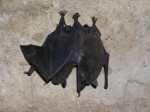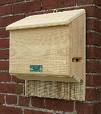 Most people probably don’t want one fact about bats, let alone 10, but I’ll bet if you read this you will find at least one of them interesting. I will admit that they are not my favorite animal but the head garden became involved with bats in his job working with the reclamation of abandoned underground coal mines and he has always urged me to give them a chance. I have to admit, they are pretty interesting, if I could only get over the desire to duck on the rare occasion when a bat is flying by. Only U.S. bats are considered here.
Most people probably don’t want one fact about bats, let alone 10, but I’ll bet if you read this you will find at least one of them interesting. I will admit that they are not my favorite animal but the head garden became involved with bats in his job working with the reclamation of abandoned underground coal mines and he has always urged me to give them a chance. I have to admit, they are pretty interesting, if I could only get over the desire to duck on the rare occasion when a bat is flying by. Only U.S. bats are considered here.
1. Bats are shy.
2. All of the 43 species of bats in the US are small with a body length of less than 3”.
3. When bats hibernate in the winter their body temperature goes down as much as 40 degrees F in order to conserve energy.
4. Bats eat insect pests such as cucumber and potato beetles, bark and snout beetles, corn borers, cut worms, and leaf hoppers.
5. Nectar feeding bats are important pollinators of many plants such as agave and saguaro cactus.
6. Baby bats are called pups and are born after 50-60 days in the mother. During birth the mother hangs upright and the pups drop out of her into a basket formed by her wings.
7. Female bats like the warmth of attics for raising their young during May – July.
8. Pups are nourished by the milk of their mom for five or six weeks (yes, bats are mammals) and are full sized and considered adults about a month after birth.
9. Bats are considered long lived, many living for 10 years.
10. You can attract insect eating bats to your garden by:
- a. Planting native plants, flowering vines, and night-scented flowers to lure insects. Possible suggestions include moonflowers (Impoea alba), Nicotiana sylvestris ‘Peacepipe’, four o’clocks (Mirablilis jalapa), evening primrose (Oenothera speciosa), night scented stock (Matthiola bicornis), and marjoram (Origanum majorana). Leave a light on near the flowers to further attract bats.
b. Provide water. A pool or bucket filled with water would be suffice.
c. Provide shelter. A rock pile or rock wall covered with vines, a group of trees, or a bat house all will give the bats a place to rest.

O.K. What do you think about bats now that you know something about them? Surely the facts about the babies hit a soft spot in your heart. What animal babies aren’t cute? There are a significant number of bat species on the endangered list and your appreciation of bats would be a step towards saving them.

I’ve always liked bats – I blame horror films for the bad press and have never worked out where the “bats getting tangled up in long hair” idea came from.
I do wince at the idea of catching the baby in folded wings 🙂
I have to admit to being frightened by the image of bats that I have seen in movies and my husbands enthusiasm for them has pushed me to look more closely at them. They do so much good for the garden I can’t help but want some in the area.
Karen
How interesting. Ihad a bat in my hairwhenI was about 8 years old. I was sleping and it landed on me and dug its claws in my scalp. I tossed and turned and it would not let go. I was so scared I became as stiff as a board and it released me and flew out the windo it came in. I just fear bats from the movies and potential for rabies. I am starting a new job working as a custodian in an old church where bats are. I will have to learn to deal with it. Also about 60 miles from my home is the only survived person that got rabies from a bat. She lives in Fon du Lac, Wisconsin. Check it out on Google and you might find it.
I am sorry to hear of our terrible experience. Any creature or plant can be a problem but I try not to condemn a whole group on the problems caused by a few horrible individuals.
bats lovers rock!
Emma,
I have a way to go.
Karen